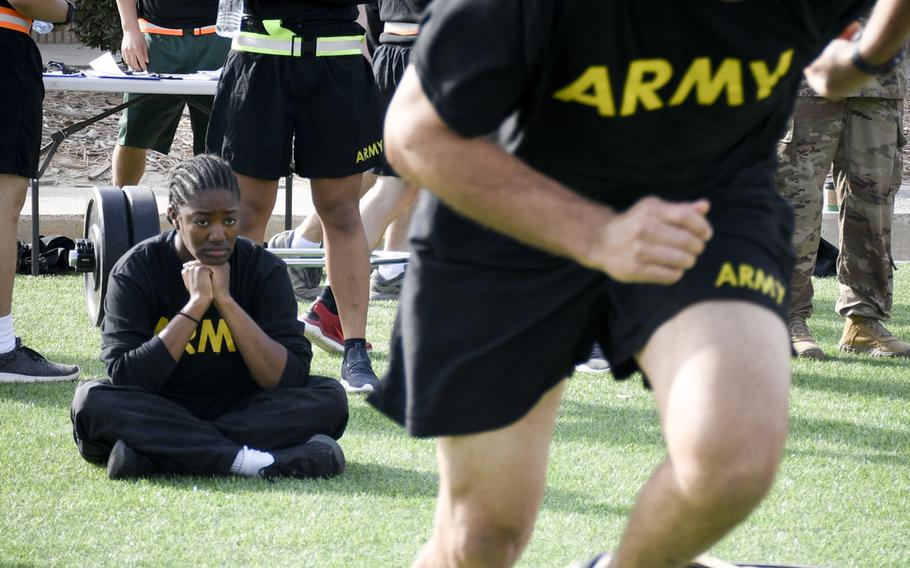
Spc. Tangela Starr watches as a soldier sprints during the new Army fitness test, conducted as a test run during deployment to Camp Arifjan, Kuwait, March 23, 2019. The new test includes exercises such as the deadlift, which proved difficult for some. (J.p. Lawrence/Stars and Stripes)
CAMP ARIFJAN, Kuwait — Lt. Col. Kristen Auge hunched her back and clenched her eyes shut as she began to deadlift. But the weight refused to leave the green turf.
Around her, a group of deployed Minnesota National Guardsmen from her battalion hefted, dragged and tossed weights in their first crack at the new Army Combat Fitness Test.
Auge, an avid runner, had always aced her fitness tests throughout her 29-year-career. But now the commander of the 34th Infantry Division’s headquarters battalion was failing several exercises in the Army’s new fitness assessment.
“We’re going to have to train them up to be better,” Auge, 51, said after the test, “and that includes me.”
The ACFT will require some soldiers to learn new movements, and some soldiers in Kuwait shared their concerns about how training for specialized exercises like the deadlift — which can cause serious injuries if done with poor form — may hold special challenges for National Guardsmen.
For the old test, training simply required time and a bit of space to run and do pushups and situps. But the new assessment requires a training space with heavy plates for the deadlifts and a pull-up rack for the leg tucks.
In Minnesota, not everyone has access to a sufficient gym, or lives close to an armory, and those in remote or rural areas may have to train alone, said 1st Sgt. Chris Swoboda, who helped set up the test.
“We live in towns in every corner of the state,” Swoboda, 43, said.
Swoboda said this was a chance to learn if soldiers were ready to take the ACFT and whether his unit was ready to administer it.
By the fall of 2020, the ACFT will be an Army-wide requirement. The evaluation includes the deadlift, standing power throw, hand-release pushups, the “sprint, drag, carry,” leg tucks and a two-mile run.
The deployed soldiers had trained for two months for this non-record, voluntary first look at the new assessment, under the supervision of a newly certified ACFT trainer.
Even on active duty, the unit was unable to find all the new gear required to train and take the test. Soldiers said they had to scrounge for equipment from other units in Kuwait.
The Army is working with the National Guard to provide equipment, said Michael McGurk, the director of research and analysis for the Center for Initial Military Training, which is responsible for the new standards. Those without equipment, such as kettlebells, for example, can substitute jugs of water, McGurk said.
Soldiers were confident the training they had received from their sergeants had showed them how to do the new exercises.
Spc. Armel Joakim, 38, said he looked forward to the ACFT, as the burly mechanic had struggled with the old test’s body-weight exercises and the two-mile run.
“The old one, you don’t have the opportunity to use your power,” said Joakim, who belongs to the 34th Infantry Division’s Headquarters Support Company.
Another soldier, public affairs specialist Sgt. Linsey Williams, wowed peers with her ease at deadlifting, hustle on the “sprint, drag, carry” and performance on the leg tucks.
But Spc. Tanjela Starr seemed more unsure about the new exercises. “I don’t know why we think this will be better,” Starr, 27, said. “It seems intense.”
Finding her deadlift form proved difficult for Starr, a supply specialist in Bravo Company in the 34th’s headquarters battalion.
With the bar on the ground and with no weights, an instructor tried to teach Starr to keep her hips low during the deadlift to avoid injury. But Starr kept her hips up and instead collapsed her shoulders toward the ground.
“They kept stopping me,” Starr said. “They said the biggest thing was my form, that I wasn’t able to sit my butt down all the way.”
Among National Guardsmen, the new test will require units to anticipate possible injuries for soldiers training on their own, said Lt. Col. Sean O’Mara, division surgeon for the 34th Division, adding that he hopes soldiers train only under the guidance of professionals.
The Army says the tests will reduce injuries by building fitter troops, and that the ACFT provides a better measure of how soldiers will perform in combat. The service spent six years developing the assessment and joins the Marines, Navy and Air Force in recently creating new fitness standards.
Troops in 63 battalions started taking the test in October in an experimental study to get suggestions on any potential adjustments. Preliminary results show the leg tucks being the most difficult for soldiers, Army officials said, with soldiers also reporting times in the two-mile run that are 30 to 60 seconds slower than in the old test.
Because the ACFT is more intense, soldiers will no longer be able to procrastinate in practicing for it, said Command Sgt. Maj. Joseph J. Hjelmstad, 34th Red Bull Infantry Division’s senior enlisted advisor.
In Minnesota, where the division is based, ROTC units at two universities had a 60% pass rate in trials with the ACFT, compared to a typical 90% pass rate with the old test, Hjelmstad said.
“The ACFT is coming – don’t freak out, work out,” Hjelmstad said to his soldiers.
At Camp Arifjan, the test’s end led to rosy reviews by soldiers like Joakim and Sgt. Jade Dueffert, training sergeant for the 34th’s headquarters support company.
“This is a better measure of total fitness, for the whole body,” Dueffert said.
lawrence.jp@stripes.com Twitter: @jplawrence